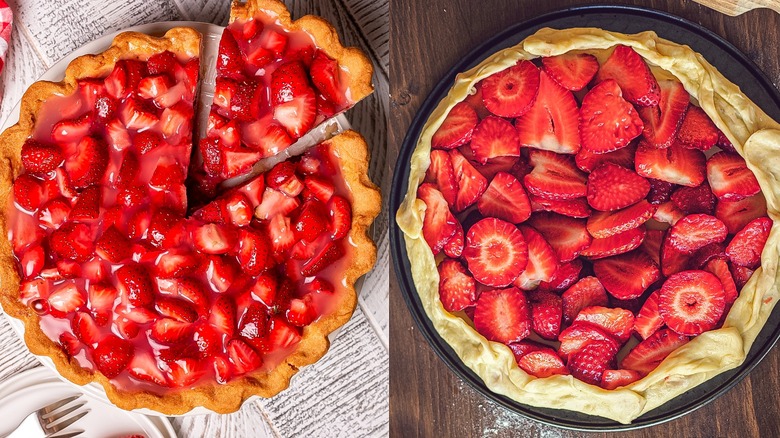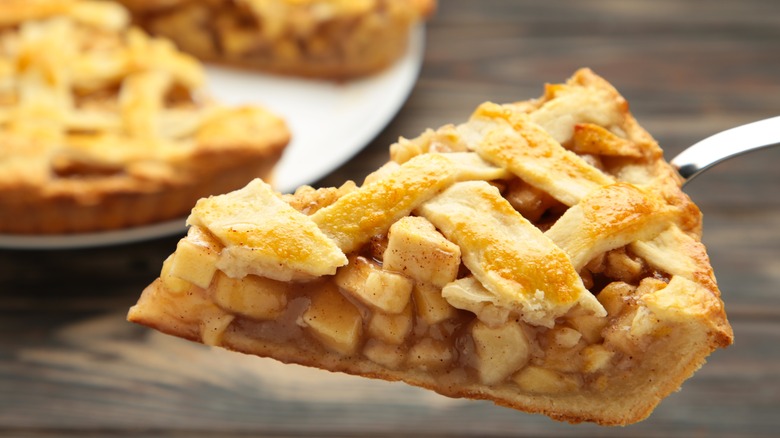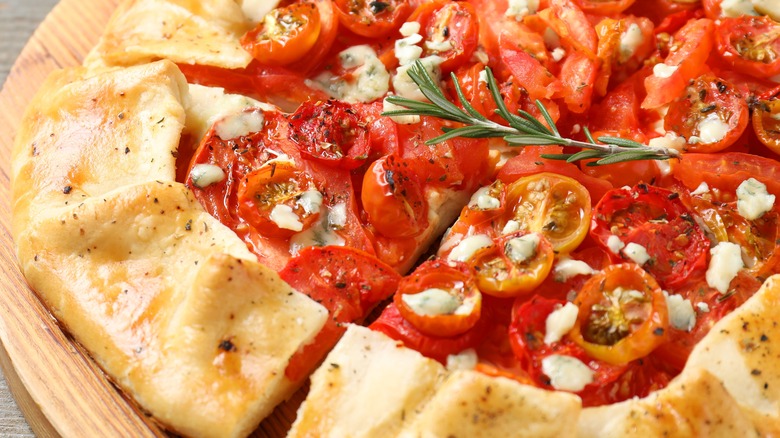Pie Vs Galette: What's The Difference?
There are many wonderful things to do with pastry, two of which are the pie and the galette. While you're undoubtedly familiar with the pie, the galette is less ubiquitous. So what's the difference between these baked treats, and when would you opt for one over the other?
On paper, the pie and the galette could be the same. In fact, some would consider the galette to be a subcategory of the pie family. They're both constructed of pastry, with a sweet or savory filling. Where the key difference lies is the preparation.
A pie's pastry is usually pressed into a tin or dish with sloped sides, often with crimped edges. After filling it can be closed with a top crust, or half covered with latticework pastry. A galette, however, starts with rolled out pastry, which is then folded around the filling to create a free-form, open-faced pie that's cooked on a baking sheet.
A pie is ideal when you want to impress. It's easy to cut into neat slices, and works with any kind of filling. A galette might not win so many awards for beauty, but it can be quicker and easier to make, and the always open center lets farm-fresh produce shine.
What is a pie?
You might think the pie needs no explanation, but if you look at a list of pie recipes, you'll everything from hot and savory to cold and sweet. The definition generally agreed on is that it's a pastry crust with some kind of filling, but this leaves room for a lot of interpretation.
Let's start with the base. A standard pie dough is what you'll find in a classic apple pie, but look to a chicken pot pie and you'll find a light and flaky pastry topping. At the other end of the scale, a key lime pie has no dough in sight, but instead a buttery graham cracker crust.
When it comes to filling and baking, there's also leeway. A standard pie crust will certainly need to be cooked, and there are plenty of fillings that also need cooking, like with a classic pumpkin pie. But blind baking the crust alone opens the door to fresh fillings as you find in a banana pudding pie.
If you're looking for versatility, a pie is certainly your best option, but it will take more time and a little more precision to make than a galette.
What is a galette?
In its home country of France, the word galette is used for a few different dishes. For example, a galette des rois (an enclosed frangipane pie), or a Breton galette (a savory buckwheat pancake), but we're refering to a rustic pastry tart.
While the form is more relaxed, there are fewer variations on the pastry galette. Due to the way the galette is constructed, you won't find latticework tops or fully covered galettes — the best you can do is fold the sides over closer to the middle.
For the same reason, a galette can't be blind baked or contain liquid fillings — the filling and the dough are baked together. The upside of this is that galettes can be a quicker option than making a pie.
The filling for a galette can be sweet or savory, and often makes use of seasonal produce. An heirloom tomato galette is a classic example, but almost any vegetable filling will work. Add some cheese and it will caramelize nicely thanks to the open top.
The base of a galette is typically a standard pastry dough, which can be flavored to suit the filling. Sugar is added for fruit galettes, and savory galette dough might include herbs or cheese.
Because you're not restricted by the baking dish, galettes can be any size, perfect for using up the last of your fresh fruit or vegetables. Mini individual galettes also make a nice entree served with a green salad.


